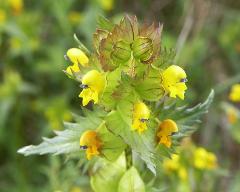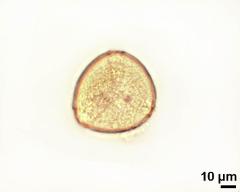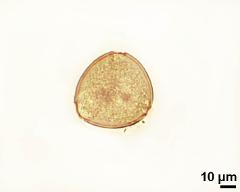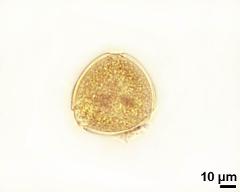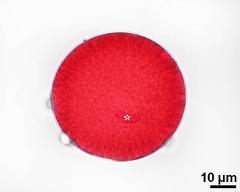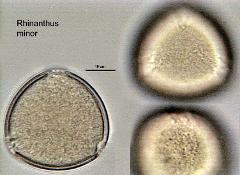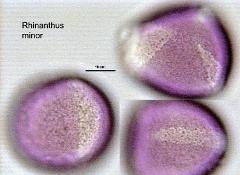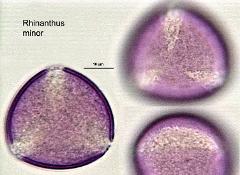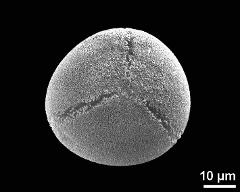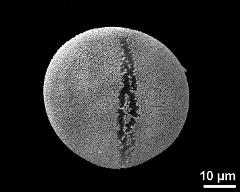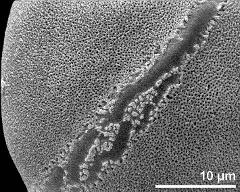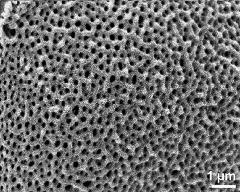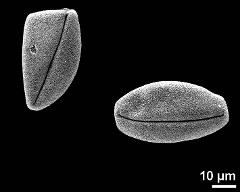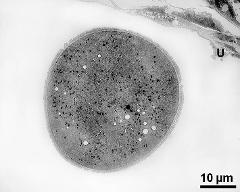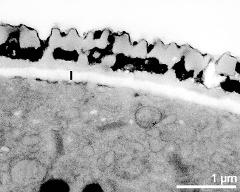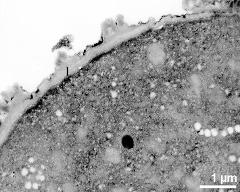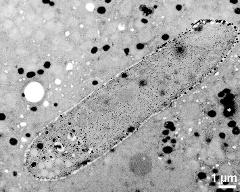Rhinanthus minor
Taxonomy: Angiospermae, Lamiales, Orobanchaceae, Rhinanthus
Links: http://flora.nhm-wien.ac.at/Seiten-Arten/Rhinanthus-minor.htm
Published: 2020-12-15
Pollen Description
Shape, Size and Aperture
pollen unit: monad, dispersal unit and peculiarities: monad, size (pollen unit): medium-sized (26-50 µm), size of hydrated pollen (LM): 31-35 µm, 36-40 µm, shortest polar axis in equatorial view (LM): 26-30 µm, longest polar axis in equatorial view (LM): 31-35 µm, shortest diameter in equatorial or polar view (LM): 31-35 µm, longest diameter in equatorial or polar view (LM): 31-35 µm, pollen class: colpate, polarity: isopolar, P/E-ratio: -, shape: spheroidal, outline in polar view: circular, dominant orientation (LM): oblique, P/E-ratio (dry pollen): prolate, shape (dry pollen): -, outline in polar view (dry pollen): irregular, infoldings (dry pollen): aperture(s) sunken, aperture number: 3, aperture type: colpus, aperture condition: colpate, tricolpate, aperture peculiarities: aperture membrane ornamented
Ornamentation and Structure
LM ornamentation LM: scabrate, nexine: -, sexine: -, SEM ornamentation SEM: microreticulate, suprasculpture SEM: -, TEM tectum: semitectate, infratectum: columellate, foot layer: continuous, endexine: absent, intine: monolayered, wall peculiarities: -, supratectal element: -
Miscellaneous
pollen coatings: pollenkitt, reserves in cytoplasm: lipids, cell number: 2-celled, Ubisch bodies: present
Author(s) of diagnosis: Loos, Claudia; Heigl, Helmut
Pictures
Picture legend
- flower(s), photographer: Svojtka, M.
- polar view, upper focus - fresh, acetolyzed, unstained, photographer: Loos, C.
- optical section - fresh, acetolyzed, unstained, photographer: Loos, C.
- polar view, lower focus - fresh, acetolyzed, unstained, photographer: Loos, C.
- pollen grain with generative cell (asterisk) - fixed, glutaraldehyde, aceto-carmine, photographer: Loos, C.
- hydrated pollen - fresh, glycerine, unstained, photographer: Heigl, H.
- hydrated pollen - fresh, glycerine, ruthenium red, photographer: Heigl, H.
- hydrated pollen - fresh, glycerine, ruthenium red, photographer: Heigl, H.
- polar view - fresh, rehydrated (water) & critical point dried & sputter coated with gold, photographer: Loos, C.
- equatorial view - fresh, rehydrated (water) & critical point dried & sputter coated with gold, photographer: Loos, C.
- detail of aperture - fresh, rehydrated (water) & critical point dried & sputter coated with gold, photographer: Loos, C.
- exine surface - fresh, rehydrated (water) & critical point dried & sputter coated with gold, photographer: Loos, C.
- dry pollen grains - dry, sputter coated with gold, photographer: Loos, C.
- hydrated pollen grain - fresh, glutaraldehyde & osmium & potassium ferrocyanide, uranyl acetate & lead citrate, photographer: Loos, C.
- interapertural area of pollen wall - fresh, glutaraldehyde & osmium & potassium ferrocyanide, uranyl acetate & lead citrate, photographer: Loos, C.
- aperture - fresh, glutaraldehyde & osmium & potassium ferrocyanide, uranyl acetate & lead citrate, photographer: Loos, C.
- vegetative nucleus - fresh, glutaraldehyde & osmium & potassium ferrocyanide, uranyl acetate & lead citrate, photographer: Loos, C.
Literature
- (1967) Über das zweikernige endopolyploide Antherentapetum von Rhinanthus. Phytomorphology 17: 188-195
- (1963) Das Verhalten von B-Chromosomen besonderer Ausbildung in den endopolyploiden Riesenkernen des chalazalen Endospermhaustoriums von Rhinanthus. Österr Bot Z 110: 468-480
- (1998) Preparing living pollen material for scanning electron microscopy using 2,2-dimethoxypropane (DMP) and criticalpoint drying. Biotechnic Histochem 73: 137–143
- (1994) Exkursionsflora von Österreich : 1180
Copyright and Citation
Cite this publication as:
Loos C., Heigl H., Svojtka M. 2020. Rhinanthus minor. In: PalDat - A palynological database. https://www.paldat.org/pub/Rhinanthus_minor/304519;jsessionid=CA5C98E7DC882E44AA6EBBB6077AAA95; accessed 2025-10-16

